

The general public are often the most active of the ‘environmental policemen’ as the sense of smell is such a sensitive characteristic of many of the human race. Companies who either handle or produce sulphur-containing compounds, either as intentional products or as by-products, have to handle this problem to avoid a continuous stream of complaints.
The environmental regulations do not assist in this problem as the pH of the effluent water is often one of the prime items for the award of a discharge permit but the pH has to be in a fairly close range close to neutral, that is pH 7 ±1. At these pH values the equilibrium of sulphide ions in water and hydrogen sulphide in the vapour phase is very much in favour of the latter and hence any sulphide present in solution will give rise to hydrogen sulphide in the air.
Of all the gases the sulphides are the most easily detected. It is for this very reason that the tert-butyl or iso-propyl mercaptans are used as odorants in natural gas - which in the pure state has no odour. It is claimed that the concentration that is most sensitive to human detection is in the range of 1 to 2 ppm and above this level the olfactory senses are quickly deadened by the high concentrations.
The necessity for a simple and reliable method for the on-line measurement of sulphide was of some importance. The literature revealed that the classical method for the measurement of sulphide was the so-called 'methylene blue' method and this method was developed to provide on-line measurements.
The methylene blue method
Historically, the published reference method for the measurement of sulphide was based upon the preparation of a series of standards, containing increasing concentrations of the methylene blue dye, which were contained in a series of Nessler cylinders. The colour developed from the reaction of the reagent in the sample of interest was visually compared with the prepared series of standards and hence the sulphide concentration estimated.
The procedure as published also warned that the reagent, N,N-dimethyl-para-phenylenediamine oxalate, was unstable and this would obviously present some problems for this method to be used for on-line measurements.
Requirements for on-line analysis
1. The characterisation of the complex
The complex of any component being measured by on-line photometry must have a characteristic absorption band exhibiting an absorbance maximum at a specific and an invariant wavelength. The absorption spectrum of the sulphide-N,N-dimethyl-para-phenylenediamine oxalate complex is shown in Figure 1.
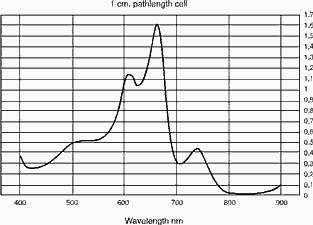
It will be observed that although the spectrum exhibits a number of small absorbance bands that the absorption maximum occurs at 670 nm and is extremely strong. The concentration of the sulphide in the above spectrum was approximately 5 ppm. Nevertheless the coloured complex formed does offer a very characteristic absorbance spectrum that indicates the possibility for direct photometric determination of sulphide in solution.
2. Stability of reagents
The caution regarding the instability of the reagent gave some cause for concern as the purpose of a process analyser is that such an analyser should operate unattended for the maximum period of time. This is becoming of increasing importance and, for example, on the SAICA river project in Spain where the process analysers to monitor the quality of the river water were located in remote sites and could only be visited a minimum of once a month. Sulphide is certainly a pollutant which has to be measured in river waters and hence our concern. Although most industrial sites appreciate that process analysers do need attention the continual necessity to replace reagents frequently is not readily accepted and the reagents must last at least two weeks.
para-Phenylenediamine and the derivatives of this compound are known to be decomposed by photochemical reaction. To avoid any photochemical reaction the N,N-dimethyl-para-phenylenediamine-diamine oxalate is packed in 5-gram portions in amber bottles that in turn are sealed in aluminium foil packets to exclude the light.
It was found that if a stock solution was prepared by dissolving the whole 5-gram portion in 50%v/v sulphuric acid solution that this solution was extremely stable. This solution has been kept for over one year and the measurements for a given concentration range of sulphide was compared with those using a freshly prepared stock solution. No difference was discernable within the normal experimental error in measuring the absorbance values usually certainly within ±0,001 AU.
This stock solution will serve for a number of analyses as the working reagent is prepared as required by diluting (in a typical case) 300 ml of the stock solution to 1 litre with de-ionised water. Since again typically only 3 ml of the working reagent is used, 5 g of the phenylene-diamine derivative will be sufficient for many analyses.
3. Preparation of standard solutions of sulphide
Great care must be taken in the preparation of standard solutions of sulphide as, even in moderately caustic solution, hydrogen sulphide is evolved from the solution. The most convenient source of the sulphide for the preparation of the sulphide solutions is the sodium sulphide nonahydrate, Na2S.9H2O. This salt is, however, extremely deliquescent and the newly opened bottle may be kept in a desiccator over silica gel for about six months depending upon the frequency with which the bottle is opened.
A typical solution is prepared as follows: 3,818 g of sodium sulphide nonahydrate was dissolved in a solution of water containing 100 ml of 1N sodium hydroxide solution. When solution was complete the solution was diluted to 1000 ml giving a solution containing 509,72 ppm of sulphide ion in a 0,1N sodium hydroxide solution.
5, 10, 15 and 20 ml of this solution were separately diluted to 1000 ml for the purposes of calibration that provided solutions containing 2,49, 4,98, 7,46 and 9,95 ppm of sulphide ion. The zero (Standard #1) was de-ionised water.
The potential instability of the sulphide solutions makes it very unreliable to use a standard solution as a source of sulphide ions for automatic calibration. The loss of sulphide ion, as hydrogen sulphide, from a standard prepared calibration solution is shown in Figure 2. During a calibration run the same sample was used over a period of time and the decrease in absorbance, resulting from the loss of the hydrogen sulphide, is clearly seen.
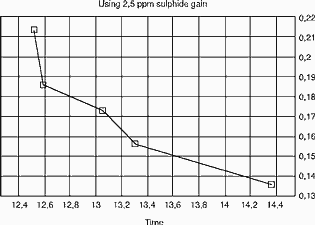
On preparing a fresh solution, by diluting the stock solution that had been kept sealed, returned the absorbance to the original value. The FPA 800, 800-S and the 803, manufactured by Tytronics, all of which are used for the on-line measurement of sulphide, have a very convenient alternative procedure for the routine calibration check (see below).
4. Reagents
The two principal reagents are prepared as follows:
Reagent #1
Dissolve the complete 5 gm of N,N-Dimethyl-para-phenylenediamine oxalate in a newly opened bottle of the salt, which had been protected from the light in 20 ml of 50%v/v sulphuric acid and stir until dissolved. Quantitatively transfer the solution into 600 ml of 50% sulphuric acid and dilute to give a final volume of 800 ml with 50% sulphuric acid. Store the solution in an amber coloured glass bottle and when not in use store in a dark cupboard.
Working reagent solution #1
Dilute 300 ml of the above stock solution to 1 litre with de-ionised water. Note: in some cases this solution may be further diluted and thus avoiding the addition of water as an additional first step.
Reagent #2
Dissolve 250 g of ferric chloride hexahydrate, FeCl3.6H2O, in 1 litre of water.
5. Preparation of calibration curves
The necessity of preparing a calibration curve for the analyser is unnecessary during the start-up onsite although this is always done during the factory check out. Normally, on the FPA 800 the standard two-point calibration is all that is necessary, as it has already been verified that the relationship between absorbance and concentration is linear, ie, Beer-Lambert's Law is obeyed.
The intensity of the absorbance of the complex is of such a magnitude that above a full-scale measurement of 5 ppm it is necessary to add water as Reagent #1 to dilute the sample and bring the measured absorbance within an analytically measurable and reliable range. The FPA 803 (which has three reagent pumps instead of the normal two) is therefore used for these higher levels of sulphide and the Reagents #1 and #2, described in 4 above become Reagents #2 and #3 in this system.
Even for a measurement range of 0 to 5 ppm a much shorter path length of the probe is used, 0,5 cm in place of the normally used 1 cm.
6. Method of analysis
The method for developing the colour of the sulphide-para-phenylenediamine oxalate complex is the same for the calibration check as well as the sample. In a typical measurement range of 0 to 10 ppm, 9 ml of the sample is captured. The sample is captured (2) using the patented technique used on all the FPA series of wet chemistry process analysers. 45 ml of water added to dilute the sample. (This water is usually supplied, with suitable pressure regulation, from a potable water supply). This is followed by the addition of 3,0 ml of the Working Reagent #1 solution and then the addition of 1,5 ml of the ferric chloride Reagent #2.
The blue coloured complex is formed very quickly and the solution is stirred for 1 minute to ensure complete development of the complex prior to measuring the absorbance. The calibration curve is prepared in exactly the same way as described above by using the known concentration of sulphide solutions. A typical calibration curve for the measurement of 0 to 5 ppm of sulphide is shown in Figure 3.
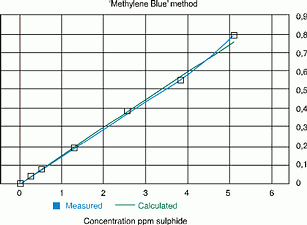
Experience has taught us that higher levels of sulphide are needed to be measured and as high as 0 to 20 ppm have been measured using this method. This is about the highest limit for the method as it is, as previously stated, an extremely sensitive method and is more applicable to the lower levels of sulphide. Levels above 20 ppm would be measured by titration using silver nitrate and the FPA 301 process potentiometric titrator with a silver electrode.
The calibration curve for the measurement of 0 to 20 ppm shows some departure from linearity at the higher levels, see Figure 4. It was suspected that this arose from the addition of the acidic reagent #2 which would cause the evolution of traces of hydrogen sulphide from the solution at this higher level of sulphide content.
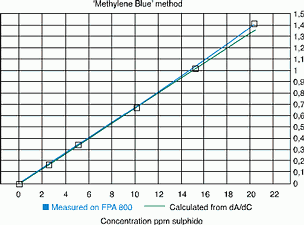
This was to some extent confirmed as the rate of addition of the Reagent #2 had a profound effect upon the responsivity. In both cases, using different rates of addition, the calibration curves were both linear but that obtained with the fastest rate of addition of the Reagent #2 should have the higher absorbance values, hence was giving the greater sensitivity. Presumably, the faster addition of the acidic reagent minimised the loss of hydrogen sulphide.
This loss of hydrogen sulphide is understandable as it was stated in the section on the preparation of standard calibration solutions there is equilibrium between the sulphide ion in solution and hydrogen sulphide in the vapour phase. The faster addition of the para-phenylenediamine reagent followed by the addition of the ferric chloride reagent minimises this loss. The effect of the rates of addition of the acidic reagent #2 is shown in Figure 5.
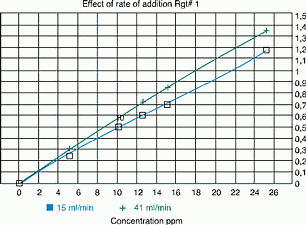
Typical results
The method is both extremely sensitive and reproducible. To date all the units installed have been operating in the higher ranges of 0 to 10 and 0 to 20 ppm but it will be obvious from the extent to which the samples have to be diluted and the corresponding absorbencies obtained that very low levels of sulphide could be measured.
Table 1 illustrates the accuracy of this process analyser when known samples were run in the analysis mode and the results obtained are perfectly acceptable for control purposes although at the higher level a greater variation was observed.

In Table 1 it will be noted that the faster addition of the para-phenylenediamine reagent minimised the loss of hydrogen sulphide.
Routine checking of the calibration
As mentioned above, the stability of the standard sulphide solutions is very problematic and hence is not suitable for the routine automatic checking of the calibration of the FPA 800 series.
The FPA 800 series does, however, have a routine in the calibration menus that is CAL ON 1 UPD 2?. What this means is that the calibration is automatically checked using Standard #1 (which is normally in these measurements de-ionised water) and that the absorbance of Standard #2 will automatically be adjusted to maintain the same difference in absorbance (a) for the measurement range.
The basis for this assumption is based upon the following facts. The absorbance measured for any concentration is given by the equation:
A = a . b . c
where
A = the measured absorbance
a = the molar absorbivity of the complex formed
b = the path length of the probe
c = the concentration for the range of measurement.
The three parameters, a, b, and c are constants for the particular measurement range and hence the absorbance, A, for the span is also a constant. Hence, by calibrating on zero concentration (ie, using de-ionised water) and using this particular mode of the calibration menu any 'drift' of the analyser is corrected and the absorbance of the span maintained.
Obviously, it is first necessary to check the span absorbance and to also check the absorbance for the span (or at least upscale) measurement from time to time for which a new standard solution should be prepared. This procedure of calibrating on Standard 1, with the corresponding update on the absorbance for Standard 2, overcomes the problem when the calibration must be verified from time to time, eg, on a daily basis for compliance reporting.
Applications for the measurement of sulphide
Apart from the normal wastewater applications, to ensure that sulphide levels are not being exceeded, there are also a number of process applications. In addition to the standard applications of controlling the addition of coagulants to remove the sulphide or the amount of oxidising agent needed to be added, a very typical application is controlling the addition of acid to liberate the hydrogen sulphide. On an LPG plant the wash liquors containing all the sulphide residues are treated with acid and the hydrogen sulphide is sparged from the solution and either sent to a Claus recovery plant or simply sent to an incinerator.
It was found that the amount of acid could be greatly reduced, as has been indicated in several places in this paper, it is not necessary to make the solution strongly acidic to convert the sulphide into hydrogen sulphide. On an LPG plant whereas previously hydrochloric acid had been added to make the solution acidic prior to sparging with air to remove the liberated hydrogen sulphide it was found, with the analyser in place, that very little hydrochloric acid had to be used. A combination of the slight lowering of the pH of the solution and the sparging rapidly took the sulphide concentration to below 1 ppm. This saved a considerable amount of money as well as decreased the length of time the blowers had to be operated to remove all the hydrogen sulphide - a combined saving of many thousands of dollars each year.
The classical method for the measurement of sulphide has been successfully implemented on the FPA 800 series thus providing a simple, reliable, accurate and a very sensitive method for the on-line measurement of sulphide in solution. Tytronics is represented locally by Protea Automation Solutions.
For more information contact Protea Automation Solutions, 011 719 5700, [email protected], www.protea.co.za

© Technews Publishing (Pty) Ltd | All Rights Reserved